| |
The Little People
From all around the world (in their lore and legend)
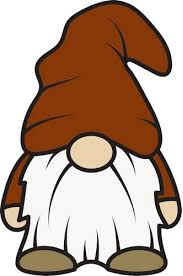
Clipart from Clipart
Library.
by Leon of Leon's Planet
(Please note: This is mostly done; but I may add to it
as more information becomes available)

A section all about Fairies!
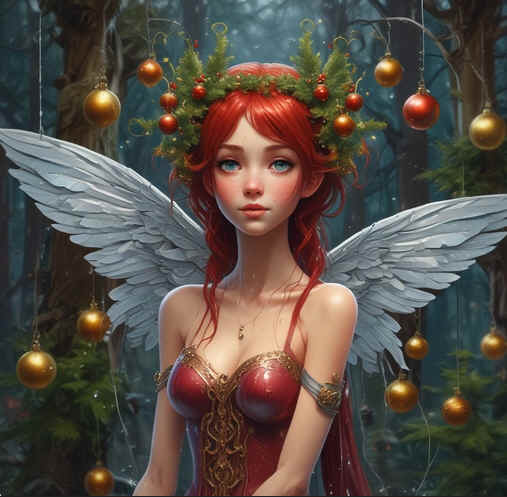
Image created by A.I. and Leon.
All images on this website may be copied, but give credit where credit is due
and link back to my website.
Click here to go directly to the fairy
section.
Foreword / Nomenclature
Growing up, I thought that gnomes came from the
North, like Alaska and Scandinavia. Imagine my surprise that the word
"gnome" is actually from the Greek language meaning
"Earth-dweller" or "Earth-wanderer" (geo + nomad = g-nome).
And, it fits, since most (if not all) of the legends worldwide say that these
creatures live underground caverns and caves. Hence, I will use the word
"Gnome" in the general sense of all little people that live
underground.
Source: Online
Etymology Dictionary.
Introduction
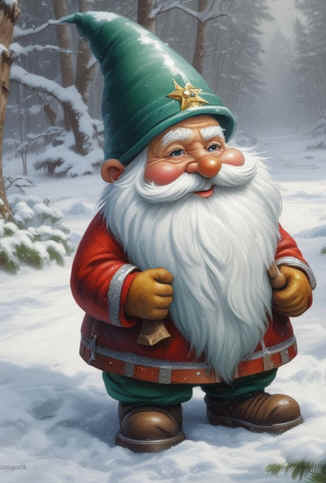
"Christmas Gnome"
Image created by A.I. and Leon.
Probably
the most famous little people are the gnomes, leprechaun, and fairies. But, did you know that
almost every culture around the world has legends of the little people?
Known by different names, are they talking about the same species, with many
different subspecies? Or are talking about many different species of
little people? As I did research for this page, I was amazed by the myriad
of stories that I found all around the world. I'd like to share my
findings with you. Please note, that this page was not created to be the
encyclopedia of all gnomes in every culture, but I did my best to include as
many as I could find. Links are provided, not only as my sources; but also
for you, the reader to do more research, if you like. Please keep in mind
that this is a work in progress, and I'll add more information as I get it.
Map
by Leon

Map made by Leon of Leon's Planet.
Permission to copy granted, but please give credit where credit is due.
And please link back to this site.
Table of Contents
Fairies
ETYMOLOGY:
The word "fairy" comes from the French word faerie, which evolved from
the word fae, which is related to the Latin word fata (The Fates); but fairies
are quite different from the fates of mythology. (Source).
HISTORY:
According to J.J.R. Tolkien, fairies were originally human-sized. (Source).
The idea or concept of diminutive humanoid winged beings may have been conflated
with the original fairies over time; And, thus the word "fairy" has
become an umbrella term for magical beings whether they have wings or not.
For instance, Morganna (Morgan Le Fay) was a real human (witch) with magical
powers that she learned from Merlin, and she was called a "fairy" by a
French writer. (Learn more about witches--real
witches--of history on Leon's Planet).
Disney popularized the diminutive little winged
fairy archetype with Tinker Bell from the animated movie "Peter Pan".
Fairies have always been known to be mischievous,
sometimes helpful, but always magical. Some records suggest they come from
another land (what we today would call another dimension of time and
space). Also, some records suggest that they can change size.
Personally, I love the idea of fairies, whether
they are real or not and no matter what size they are. And, so here I
present some A.I.-created imagery of some fairies (i.e., by Leon and A.I. in
collaboration).
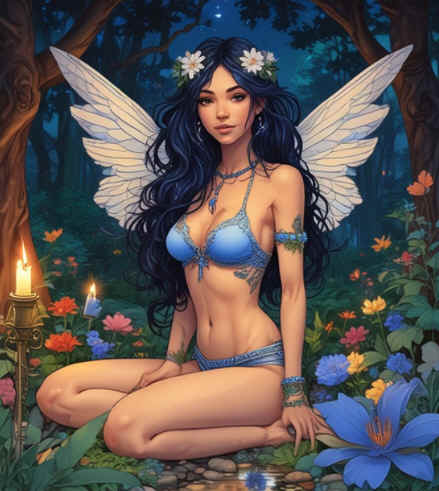
Brunette Fairy in Blue |
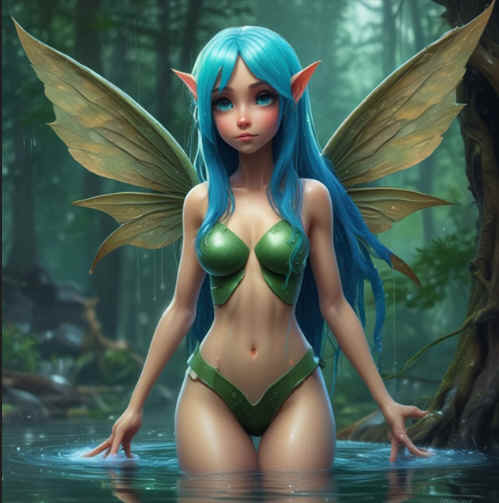
Teal-haired Fairy in Green |
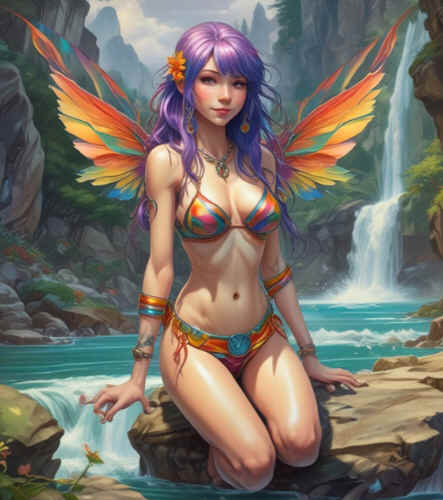
Purple-haired Fairy in Rainbow colors |
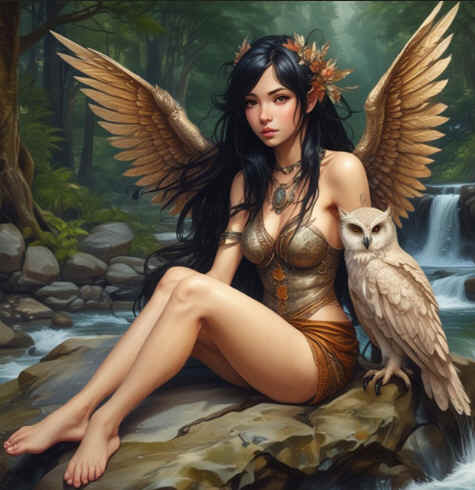
Owl Fairy |
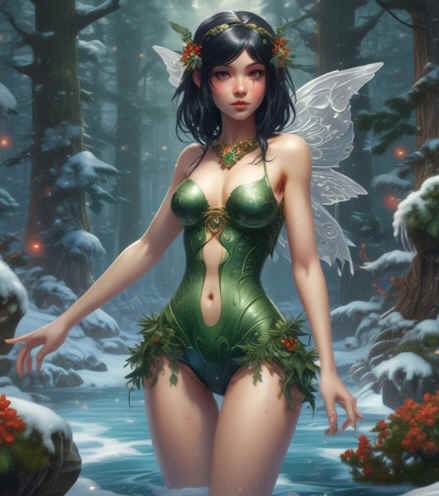
Christmas Fairy in Green |
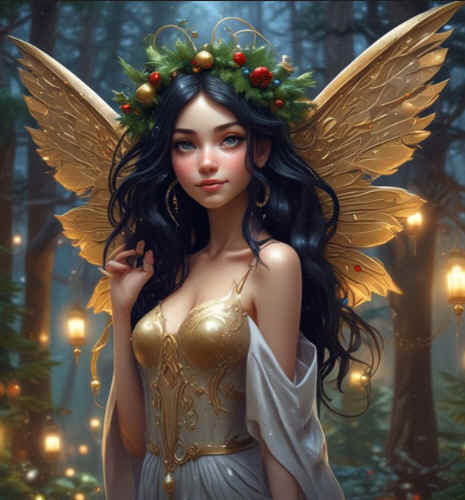
Christmas Fairy in Gold |
That's all you get here; So, if you want more images of
fairies, please follow me on...




Little People by Continent & Culture
Africa
| Culture |
Name (N) &
Demeanor (D) & Height (H) |
Other
Information |
Sources &
Miscl. Info. |
| East Africa |
N:
Agogwe
D: Rarely seen (prefer to stay hidden from humans);
respected as a humanoid life.
H: 4ft. |
Not much is known. Two
sightings by Western men have been recorded, and both recorded that the
adults were about 4 feet tall. Natives forbade the shooting of the
little people, so they must be respected by the East-African people. |
Wikipedia. |
| Madagascar |
N: Vazimba
D: Unknown; there are no records of sightings in recent
memory; only lore that they were the first inhabitants of the island.
H: Unknown, but the Bantu average 5'6'' tall and the
Vazimba were significantly shorter than that. |
They are the first inhabitants of
Madagascar and are believed to have migrated there from Borneo, Indonesia
(must be related to the Indonesian Ebu Gogo). They did some farming
(such as cultivating banana trees); but did not engage in animal husbandry
or metallurgy. They apparently settled in the highlands near rivers
and lakes, until they were forced out by or absorbed by Bantu-African
settlers.
NOTE: Bantu men average 5'6" tall and Borneo men (in 19th
century) averaged 5' tall. The average height of men in Madagascar
today is 5'4" tall.
I think what we've got here is not a "little people" but
rather a pygmy race. The Vazimba were probably a pygmy race of
humans. By definition a pygmy race of humans can have an average
height of no more than 5'. And, if you average in the height of the
women, the Borneo people of the 19th-century studies averaged 4'9". |
Genetic studies reveal that the
peoples of modern-day Madagascar are varying degrees of a mix of African
(Bantu) and South-east Asian (Borneo).
Wikipedia (Vazimba).
Wikipedia (Malagasy).
HAL-Open
Science. |
| Senegal |
N: Yumboes
D: Other than stealing corn from the humans, they were not a
threat.
H: 2 feet. |
Yumboes were white
with silver hair standing about 2 feet tall. They have been called
"spirits", but they did very physical things, like eat corn and
fish. |
Wikipedia. |
| West Africa |
N: Aziza
D: Nice
H: Unknown, but they were small enough to live in an anthill or
in the trunk of a tree. |
The Aziza were
hairy little hominids that lived in anthills and in the silk-cotton
trees. Some have called them "fairies," but they don't
have wings, but then again, neither did the original fairies of
lore. So, could they be fairies? Who knows? |
Wikipedia
(Aziza).
Wikipedia
(West African Religion). |
Asia
| Culture |
Name (N) &
Demeanor (D) & Height (H) |
Other
Information |
Sources &
Miscl. Info. |
| China (mainland) |
N: Wang-Liang
D: Evil
H: 3ft.
|
There were there evil entities
(often translated as "demons" but these so-called
"demons" did very physical things).
(1) Wang-liang: Described as the height of a 3-year-old
child, dark-skinned, red-eyed, long pointy ears, and a beautiful
head of lush black hair.
(2) Wang-xiang: not described but said to be a creature of the
waters.
(3) Fang-liang: not described but said to live in the
Earth, and feeding on the bodies of dead-and-buried humans. |
Wikipedia. |
| India |
N: Guhyaka
D: Good
H: Unknown
|
Guhyaka is a shapeshifter.
They are half horse, half bird (Pegasus?) in the sky and then look like
a gnome when on land. |
Wikipedia. |
| Japan - Ainu |
N: Korpokkur
D: Shy
H: Unknown
|
Kor (Butterbur plant) + Pok
(Under) + Kur (Person) = People that live under the Butterbur
Plant. The Korpokkur lived in pits, with roofs made of Butterbur
leaves (photo of Butterbur below).
The story is that the Ainu had a gift-exchange thing set up that
allowed the Korpokkur to not be seen. The Ainu would leave gifts
out during the day, and the Korpokkur would come at night, take the
gifts, and leave gifts in exchange.
But, one day an Ainu man decided that he wanted to see a Korpokkur,
so he waited by the window of his hut, and when he saw the Korpokkur
come, he ambushed it, grabbed it by the hand and drug it into his hut,
where he could see it better by the light of the fire. It turned
out to be a beautiful Korpokkur woman. But, she was enraged by the
Ainu's rudeness, and since that day, the Ainu have not received any
gifts from the Korpokkur, nor have they seen one.
|
Wikipedia. |
|
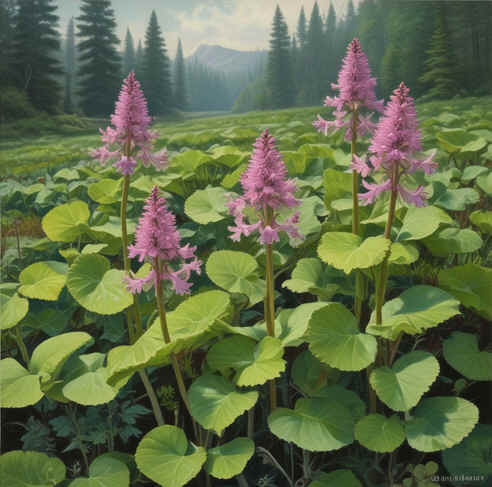
Butterbur Plant (by A.I. image-generator)
|
| Japan - Okinawa |
N: Kijimuna
D: Trickster
H: 3ft.
|
The kijimuna are said to look
about the height of a 3 or 4 year-old, and have red hair (all over their
bodies). They live in Banyan trees. |
Wikipedia. |
| Korea |
N: Dokkaebi
D: Mischievous
H: Unknown
|
The Dokkaebi are
small humanoid creatures that are mischievous and play tricks on humans.
Also, they have supernatural powers. The only description
is: "fearsome". |
Source: Me;
I lived in Korea for 10 years and that's how I learned of the
Dokkaebi. |
| Southern Russia |
N: Polevik
D: Evil
H: Unknown |
The Polevik have green hair
(some say grass for hair) on their heads. They are evil, because
it is said that they kill people who fall asleep in field (especially
ones who fall asleep drunk). |
Wikipedia. |
| Sri Lanka |
N: Nittaewo
D: Evil
H: 3-4ft.
|
Nittaewo is a word so old that
no one knows exactly what it means, but may mean "one with long,
sharp nails" (and they are described as having long, sharp
nails. They are covered in a reddish-brown colored hair and are
said to be very strong.
Much of what we know about the Nittaewo comes from the Vedda people
(the indigenous people of Sri Lanka), who had an average height of 5
feet. And, the Vedda said that the Nittaewo were much smaller than
they. The Nittaewo were enemies of the Vedda, but less
advanced. The only way that a Nittaewo could kill a Vedda was if
the Nittaewo caught the Vedda asleep.
|
Wikipedia. |
| Taiwan |
N: Psa Ta'ai
D: Nice, with a few Naughty ones
H: 3ft.
|
According to the local native
population of Taiwan, they lived peacefully next to the Psa Ta'ai for a
long time, until some of the Psa Ta'ai men made unwanted advances toward
some of the human women. After that, the Psa Ta'ai were chased
into a tree by a cliff, and the humans cut it down killing all of the
Psa Ta'ai, except two males.
They were a short, dark-skinned people.
Since then, the humans have performed the dance of a Psa Ta'ai to
appease the spirits of the dead every year during the Psa Ta'ai
Festrival.
|
Wikipedia. |
Austro-nesia
| Culture |
Name (N) &
Demeanor (D) & Height (H) |
Other
Information |
Sources &
Miscl. Info. |
Australian
Aborigines
(Noongar Tribe) |
N: Woodarjee
D: Mischievous, and sometimes violent
H: 1ft.
|
The Woodarjee look just like the
aborigines, but are only about a foot tall.
There is an interesting story about a sighting on the link provided to
the right.
It seems that there is something otherworldly about these creatures,
for any injuries incurred to you will disappear as soon as the woodarjee
disappears.
|
Sasquatch
Chronicles. |
Australian
Aborigines
(Noongar Tribe) |
N: Bulyit
D: Evil
H: 2ft. |
The Bulyit is a small (2ft-high)
hairy man, that comes out after dark, and will carry children off in the
night. That's why children are not allowed to be out after dark. |
Noongar
Culture.
|
Australian
Aborigines
(Tiwi Tribe) |
N:
Walatha-Walatha
D: Good
H: 2ft |
In the North, they are called the
Walatha-Walatha. Their natural appearance is that of small hairy
person, with a pungent smell; but they can shapeshift. If you are a
good person, they can act as your guardian angels. |
CDU-Australia. |
| Indonesia, Flores |
N: Ebu Gogo
D: Not nice.
H: 5ft. |
Ebu Gogo = Ebu (Grandparent) +
Gogo (Omnivore).
The Nage (the people who now occupy Flores) were enemies to the Ebu
Gogo, and the Nage may have exterminated the Ebu Gogo, because the Ebu
Gogo would steal the Nage children and try to cook/eat them.
But, If they were 5ft tall, they would qualify as a pygmy human, and
not one of the little people. |
Wikipedia. |
| Indonesia, Flores |
N: Homo Floresiensis
D: Unknown
H: 31/2ft.
|
Scientists in Flores, Indonesia
found a skeleton of a 3ft-tall, fully grown adult hominid, that they named
"Homo Floresiensis" after the place where it was found.
The skeleton is purported to be 50,000 years old. Despite its
age, this discovery lends credence to the existence of the little people.
It has been nicknamed the "Hobbit of Indonesia".
|
Wikipedia.
|
|
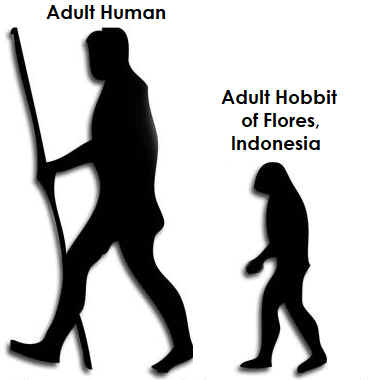
|
Europe
| Culture |
Name (N) &
Demeanor (D) & Height (H) |
Other
Information |
Sources &
Miscl. Info. |
British
(Cornwall, Devon) |
N: Pixies
D: Good
H: Varies
|
Pixies are in general smaller than
humans and are considered a completely different species than
fairies. They don't have any wings, but they have magical
powers. They tend to be poorly dressed.
They are said to reward good behavior from the humans and punish bad
behavior.
|
Wikipedia. |
British
(Cornwall, Devon) |
N: Knockers
D: Mischievous
H: 2ft. |
Knockers are a subterranean
version of the Pixies (But Pixies are said to live in caves and
underground caverns). Miners are the only ones who've encountered
these, and have attributed lost tools to the Knockers. They are
obviously called "Knockers" because the knocking sounds they
make.
In Cornish miner lore, they knock on the walls to warn of impending
collapse.
|
Wikipedia. |
British-French
(Guernsey, UK)
Guersnsey is an island close to France, but is a depency
of the UK.
|
N: Jetin
D: Not evil, but not good either. The ones that steal
human babies are obviously bad.
H: 11/2 ft. |
Their name comes from their
ability to "jet" big rocks (usually in defense).
They live in sea caves on the shores of the island of Guernsey located
between Brittany and Normandy (France) and are akin to the French Lutin.
They are said to be changlings and sometimes kidnap human babies and
put a changling in the baby's place. |
Wikipedia. |
British-French
(Breton, France)
Breton is the peninsula in Northwestern France and means
"Brittany". |
N:
Korrigan
D: Good and Bad
H: Unknown (varies) |
Etymologically related to the
Cornish word Korrik (which means fairy), the Korrigan are considered the
same as the Lutin of France (and these are the good kind).
However, there is a bad kind, said to be mostly very beautiful women
(who like sirens) lure human men to their watery grave.
 |
Wikipedia. |
|

"Korrigan Water Nymph"
(Image created by A.I. and Leon)
|
| Dutch |
N: Kabouter
D: Good
H: Unknown |
In Dutch lore, these small
humanoids are said to be helpful to humans they like; and naughty to humans
that they don't like. |
Wikipedia. |
| French |
N: Lutin
D: Good
H: Unknown |
I couldn't find much information,
but they are considered to be much the same as the Pixie, only better
dressed. |
Wikipedia. |
| German |
N: Dwarves (Dwarfs)
D: Greedy
H: Unknown
|
We know about Dwarfs from
Scandinavian Mythology, and most of that information comes from a
collection of prose and poetry written by a man (named Snorri) in
Iceland during the 13th century.
BUT, linguists say that all the Scandinavian languages evolved from
German, and therefore it is supposed that the Scandianvians must have come
from Germany, having migrated North-westward from Germany. If that
is true, then we can suppose that their lore also stemmed from Germany.
The German legends tell of a supernatural race of short, but powerful
beings, who really, really like treasure. They were called Dwarfs.
|
Wikipedia. |
| German |
Klabauter
Kobold |
Same as the Dutch Kabouter. |
|
| Greece |
N: Pygmy
D: ?
H: ? |
Described by Homer as a small
people living in India and Ethiopia. |
Wikipedia. |
| Irish |
N:
Leprechaun
D: Mischievous
H: ? |
We all know about
Leprechauns, right?
They are the little people of Ireland. One of my
favorite movies is Darby O'Gill and the Little People (by
Disney). I highly recommend it, 'cause all the lore connected with
the leprechauns is in there (and a lot more). There's lots of Irish
lore in that movie. I love it! In the
movie, they were only about a foot tall.
MORE about Leprechauns below...
 |
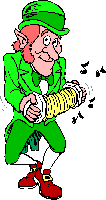 |
|
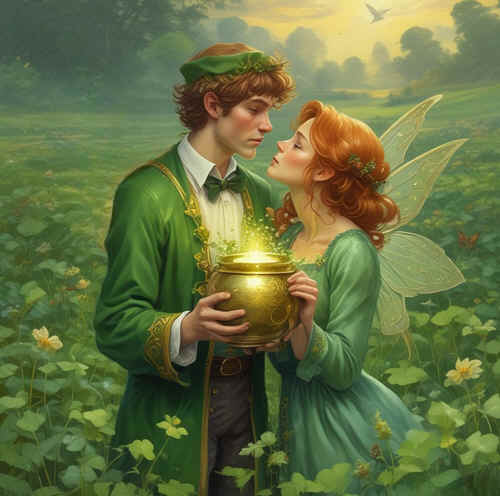
"Leprechaun and Fairy"
(Image created by A.I. and Leon)
So, one day, I got to wondering if Leprechauns and Fairies
ever interacted. So, I googled the query, and many many websites attest to
the same thing: Lo and behold, Leprechauns ARE Fairies. They
are thought to be the male fairies that have for whatever reason left the
general fairy population; for they tend to be solitary individuals.
So, it is very possible that from time to time there are interactions;
even romantic ones. |
| Mediterranean |
Greek:
Kallikantzaros
Bulgarian:
Karakondjil
Serbian:
Karakondzula
Turkish:
Karakoncolos
All variants were considered to be evil. |
In Greek it is thought to mean
"beautiful centaur"; (but that can't be right). The word
is probably "borrowed" into the Greek language. In Turkish it is thought to mean "black bloodsucker" (which
sounds about right).
___________________
They only come out in winter, at night, around the winter solstice time
and cause all kinds of mischief. Peak time is from Dec. 25 - Jan. 6. |
Wikipedia. |
| Polish |
Krasnoludek |
- (If you see a dash, it
means I'm working on it). |
- |
| Scandinavia |
N:
Danish: Nisse
Swedish: Tomte
Finnish: Tonttu
Norse: Tufte
D: Good, but easily offended...
H: Unknown |
Your typical garden gnomes are
perfect likenesses of these Scandinavian little people.
They like to help with the farm work, in exchange for gifts (usually in
the form of food). Their favorite food is porridge with lots of
butter on top.
When slighted, they will do nasty things to get revenge upon the
farmer.
So, I was right! These gnomes do come from Scandinavia! |
Wikipedia.
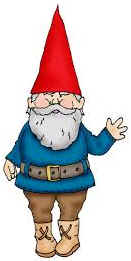
Clipart from Clipart
Library.
|
| Scottish |
N: Brownies
D: Good; but easily offended.
H: Unknown |
The story of the Elves
and the Shoemaker is the quintessential description of Brownies.
But, Brownies are easily offended and if they feel slighted in any way
they will leave and never come back.
|
Wikipedia. |
| Slavic Lore |
Karzelek |
- |
|
| Spain |
N: Duende
D: Ranges from good to mishievous
H: Unknown |
Apparently, the word "Duende"
is a general term for all little people. There are many types, and
each region has their own name for the creatures, which range from helpful
to mischievous. Check out the article on Wikipedia. |
Wikipedia. |
| Ukrainian |
Skarbnyk |
- |
|
| Welsh |
Coblynau |
- |
|
North America
| Culture |
Name (N) &
Demeanor (D) & Height (H) |
Other
Information |
Sources &
Miscl. Info. |
| Alaska |
Sungcuk
Ircenraat
jinxioc
imenaraat
|
The Sungcuk were very mischeivous,
but the others (all words for the same beings) were very evil. They
would steal children, and the children are never seen again.
They are described as being about 4ft-tall and very, very strong.
These are real flesh-and-blood creatures. There's nothing
supernatural about them, except how fast they run.
|
Alaska
Magazine.
Missing
in Alaska.
Alaska
Village to Village.
|
Native American
Tribes of the Mainland U.S. |
N: Pukwudgy
(Pukwudgie)
D: Good, Shy, maybe a bit mischievous
H: ?
|
Just about every single Native
American Tribe has legends of the little people. It's mostly a
keep-a-healthy-respect kind of thing. You don't want to offend the
little people. And, children are warned not to wander around at
night. One of the most famous is the Pukwudgy, which are short hairy humanoids
(probably half the size of a normal human). According to a
professional remote viewer (that I know), they are real creatures, who
prefer to stay hidden from humans, and can be interdimensional.
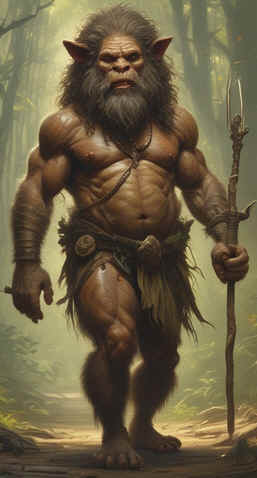
"Possible Appearance of Pukwudgy"
Pic generated by A.I. and Leon.
|
Remote Viewer:
John
Vivanco
|
| Hawaii |
- Coming soon. |
- |
- |
South America
| Culture |
Name (N) &
Demeanor (D) & Height (H) |
Other
Information |
Sources &
Miscl. Info. |
Argentina - Brazil,
and Paraguay |
N: Pombero
D: Harmless troublemaker
H: ?
|
Pombero means "Lord of the
Night", and are called thusly because they are primarily nocturnal by
nature. They are short and hairy, and prefer rural areas like
forests and abandoned houses in the countryside (unlike the brownies, with
prefer human habitations). |
Wikipedia.

Pic from Wikicommons.
|
| Western South
America |
N: Muki
D: Helpful
H: 2ft.
|
Short, with blonde hair (or white
hair and beards for the older ones), and pale skin, these creatures are
stout (brawny). Their necks are so short that it looks like their
heads are resting on their torso.
They are seen dressed like miners bearing mining equipment, and not
surprisingly, they are usually seen only my human miners.
Many stories allege that these creatures can be very helpful to miners
when they want to be.
|
Wikipedia. |
Notes from the Author of this Page
You may have noticed that I didn't mention
elves. That's because the term elf seems to be convoluted and usurped by
many to mean many different things. Most elves were shorter than humans
(and appear to be the same as gnomes), but the elves of Scandianvian lore appear
to be personifications of Natural phenomena, just as the Aesir, and Vanir, the
Dwarves, the Jotun, the Fates, and the sons of Muspelheim. Learn more
about Scandinavian lore on
my special page dedicated entirely to that genre. Here's a taste...

Gnomes in the Holidays!
| For
Halloween |
For
Christmas (Yuletide) |
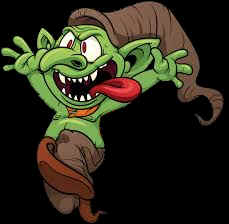
Clipart from Clipart
Library. |
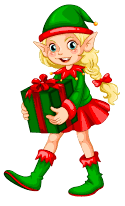
Clipart from Clipart
Library. |
| Trolls! |
Santa's Little Helpers:
Elves! |
| I
did my research and I found that trolls are related to the Jotunn of
Scandinavian Lore (In fact, they are the same thing or trolls are
a kind of Jotunn), And, although in the past the word "Jotunn"
has been translated as giants, more modern research suggests that they
weren't giants at all. In fact, the word "Jotunn" is
more likely meaning "Eater". And, they were voracious
eaters. Nobody knows what the word "Troll" means, but
the word "Troll" was used interchangeably with
"Jotunn".
Further research led me to find out
that there are many different kinds of trolls of varying sizes.
The kind that I'm talking about here are the little trolls. Little
trolls hide under bridges and try to catch little children who are alone
at night. So, don't go out alone at night! Okay?!!!
In general trolls are voracious
eaters, who will eat humans, if they can catch them. Trolls are
not as smart as humans and they move slower. And, they die when
they are exposed to sunlight. So, they only come out at night. |
Santa was born in Finland
(all the Finns know this). And, guess what?! That's where
the elves that wear red suits and red hats come from, too!
So, the movie "Santa Claus is Coming to Town" got it
right!!!! (I'm so excited about this!)
Santa Claus obviously recruited a group of Elves (Gnomes) to come
with him to the North Pole to start up his workshop there. If
you look at a map, you will see that Finland is quite close to the North
Pole.
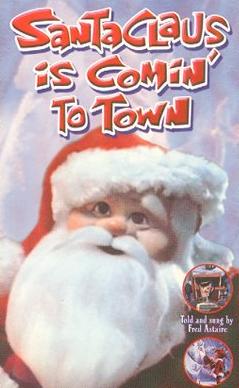
And the winter warlock was probably a troll! |
Source on Trolls.
Source on Jotunn.
Gnomes in the Arts
I recently read this (fictional, but fun) little story on Kindle, entitled:
The Adventures of
Bumble Snug and Wispy Jim
by J.R. Lewis
Please check it out, if you have Kindle.
Bumble Snug is a gnome and Wispy Jim is a cat (whom Bumble
rides). And, they go on an adventure together.
My Review:
I loved the language. I loved the plot. And, I loved the
rhyme.
The only thing I didn't like was that there are no pictures.
I am offering here and now to do the illustrations for the
book.
Contact me.
|